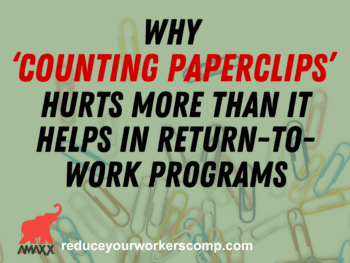
Every injured employee on transitional duty should meet WEEKLY with the Transitional Duty (TD) Coordinator, if your company has one, or the supervisor in charge of the injured worker’s return to work. There are many benefits to weekly meetings. Among them are:
It keeps employees in the loop at the workplace.
This keeps them mentally engaged in your workplace, and thus more likely to fully recover and return to work. It also keeps the employee socially connected to their co-workers and supervisors. Employees who feel valued, important and supported are more likely to want to return to work quicker.
Click Link to Access Free PDF Download
“13 Research Studies to Prove Value of Return-to-Work Program & Gain Stakeholder Buy-In”
These meetings help determine if increasing strength or capability is possible to allow the employee to assume additional job tasks. There should be a gradually increasing capacity. The employee should bring any recent medical information to the meeting. This should include any changes in medications, work restrictions and recommendations. It is good to vary the time of the meeting each week to see if the employee’s work capacity varies at different times of the day or week. For employees who cannot attend on site meetings, you might discuss options for a field-based nurse case manager to visit the employees.
It lets employees bring up any obstacles to returning to work.
Sometimes there may be simple reasonable accommodations that an employer can provide, such as an ergonomic chair or keyboard, that can help an employee return to work quicker. However, unless the employer knows about the difficulties the employee has, the employer will not be able to address these needs. You can find a vendor that provides off-site employment temporarily for employees who are unable to travel or for any other reason cannot come back to a transitional duty position in your facility.
It allows employers and employees to coordinate new TD capacity, look at new positions, and discuss transitional duty options.
If the employee is ready to increase their duties, come up with new tasks that are within their capacity. Do not make the employee feel that they are not valued or are being replaced by not allowing them to assume tasks as they are able. Employees who do not feel wanted are not going to want to come back. Customize transitional duty tasks (and job schedules) so they can be restructured easily to accommodate increased ability as the injured worker recuperates. If the employee is having some setbacks, consult your transitional duty job bank. This is a list of assignments that supervisors and employees make of a “wish list” of things they would like to have done but have not had time to do. Include these items on the transitional duty task bank.
FREE DOWNLOAD: “13 Research Studies to Prove Value of Return-to-Work Program & Gain Stakeholder Buy-In”
Guidelines for these meetings include:
• Present the cost-savings benefits of returning employees to work in transitional duty to build and maintain management commitment.
• Invite a member of management to join the injury management team.
• Work with senior management and middle managers to implement a dollar-for-dollar charge-back system to the units where losses occur.
• Design work-arounds to facilitate a timely return to work.
• Invite the employee and a family member to bring the family on board
• Make sure to mail a letter to the employee’s home address advising of the time and date of the meeting. You should also send an email reminder if the employee has internet access. The letter should request their medical restrictions and include a Work Ability Form for their medical provider to complete. Remind them to bring the completed form to the meeting.
• Provide transportation to these meetings if the employee is unable to drive.
• Make sure to coordinate your Transitional Duty Policy with all other state and federal leave and absence regulations such as ADA, FMLA, COBRA and ERISA.

Contact: mstack@reduceyourworkerscomp.com.
Workers’ Comp Roundup Blog: https://blog.reduceyourworkerscomp.com/
©2020 Amaxx LLC. All rights reserved under International Copyright Law.
Do not use this information without independent verification. All state laws vary. You should consult with your insurance broker, attorney, or qualified professional.

















